Qualitative Research Analysis: Schizophrenia and Treatment Outcomes
VerifiedAdded on 2023/06/08
|12
|2848
|57
Report
AI Summary
This report critically analyzes three qualitative research articles focusing on various aspects of schizophrenia, a mental disorder characterized by hallucinations and cognitive problems. The articles employ interviews and semi-structured questionnaires to gather data, providing insights into treatment outcomes, the role of spirituality in recovery, and the impact of exercise on individuals in early psychosis stages. The analysis assesses the rigour, strengths, and weaknesses of each study, highlighting limitations related to sampling techniques, data collection procedures, and potential biases. The report concludes by suggesting improvements for future qualitative research on schizophrenia, such as using random sampling methods and conducting unstructured interviews to address complex issues and foster egalitarian relationships between researchers and participants. Desklib provides students access to solved assignments and past papers.

Running head: REPORT
Analysis of qualitative articles
Name of the Student
Name of the University
Author Note
Analysis of qualitative articles
Name of the Student
Name of the University
Author Note
Paraphrase This Document
Need a fresh take? Get an instant paraphrase of this document with our AI Paraphraser
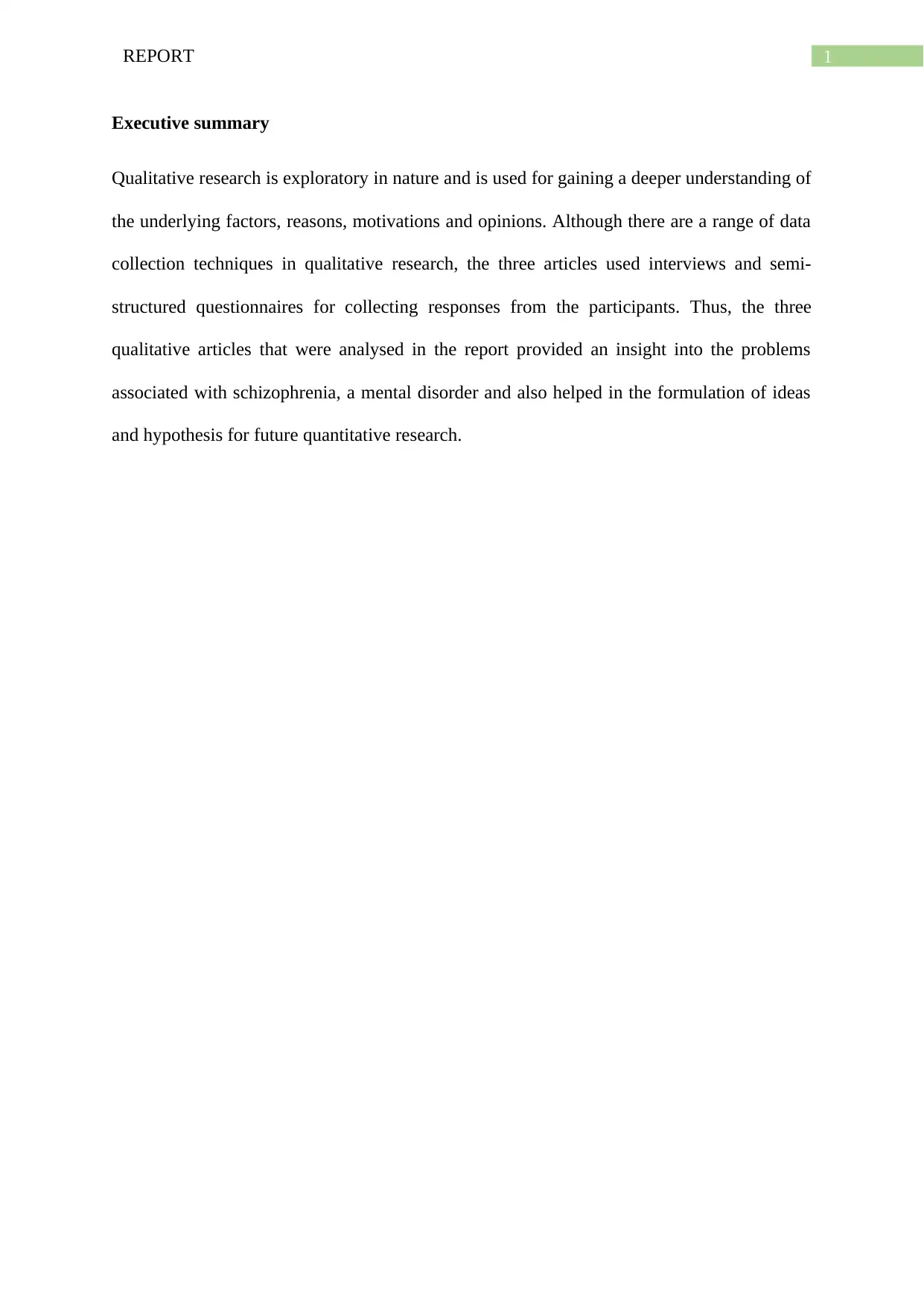
1REPORT
Executive summary
Qualitative research is exploratory in nature and is used for gaining a deeper understanding of
the underlying factors, reasons, motivations and opinions. Although there are a range of data
collection techniques in qualitative research, the three articles used interviews and semi-
structured questionnaires for collecting responses from the participants. Thus, the three
qualitative articles that were analysed in the report provided an insight into the problems
associated with schizophrenia, a mental disorder and also helped in the formulation of ideas
and hypothesis for future quantitative research.
Executive summary
Qualitative research is exploratory in nature and is used for gaining a deeper understanding of
the underlying factors, reasons, motivations and opinions. Although there are a range of data
collection techniques in qualitative research, the three articles used interviews and semi-
structured questionnaires for collecting responses from the participants. Thus, the three
qualitative articles that were analysed in the report provided an insight into the problems
associated with schizophrenia, a mental disorder and also helped in the formulation of ideas
and hypothesis for future quantitative research.
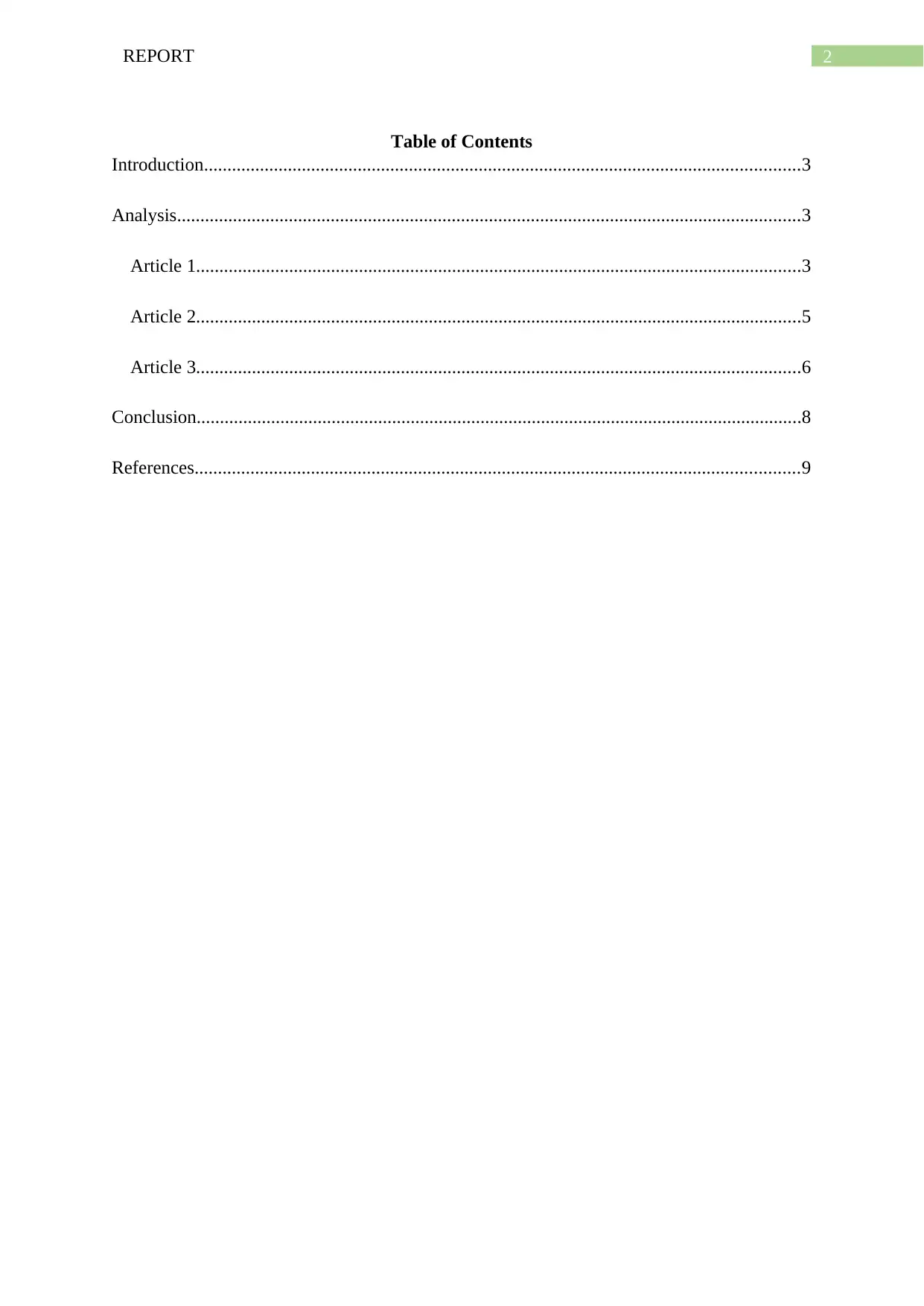
2REPORT
Table of Contents
Introduction................................................................................................................................3
Analysis......................................................................................................................................3
Article 1..................................................................................................................................3
Article 2..................................................................................................................................5
Article 3..................................................................................................................................6
Conclusion..................................................................................................................................8
References..................................................................................................................................9
Table of Contents
Introduction................................................................................................................................3
Analysis......................................................................................................................................3
Article 1..................................................................................................................................3
Article 2..................................................................................................................................5
Article 3..................................................................................................................................6
Conclusion..................................................................................................................................8
References..................................................................................................................................9
⊘ This is a preview!⊘
Do you want full access?
Subscribe today to unlock all pages.

Trusted by 1+ million students worldwide
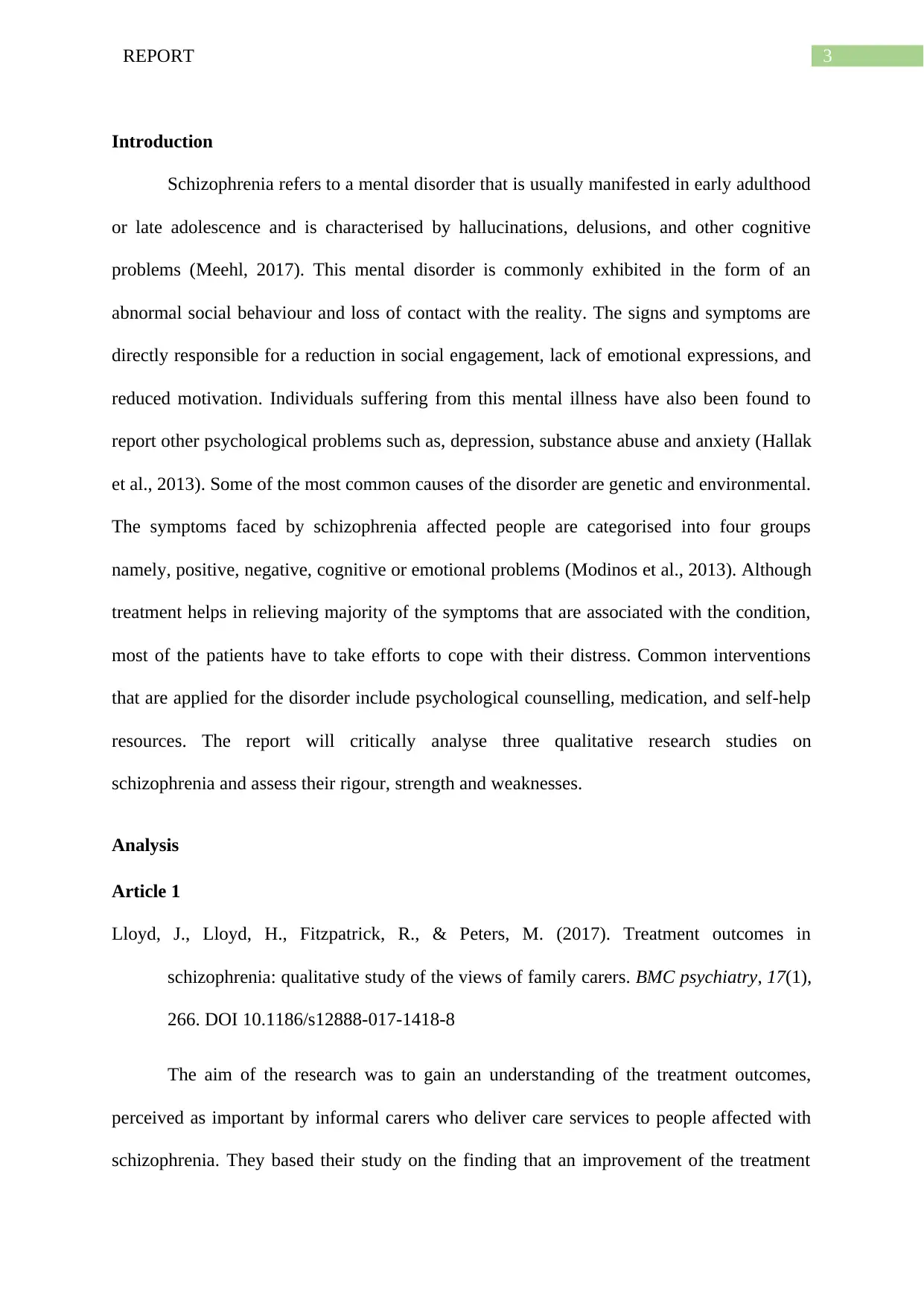
3REPORT
Introduction
Schizophrenia refers to a mental disorder that is usually manifested in early adulthood
or late adolescence and is characterised by hallucinations, delusions, and other cognitive
problems (Meehl, 2017). This mental disorder is commonly exhibited in the form of an
abnormal social behaviour and loss of contact with the reality. The signs and symptoms are
directly responsible for a reduction in social engagement, lack of emotional expressions, and
reduced motivation. Individuals suffering from this mental illness have also been found to
report other psychological problems such as, depression, substance abuse and anxiety (Hallak
et al., 2013). Some of the most common causes of the disorder are genetic and environmental.
The symptoms faced by schizophrenia affected people are categorised into four groups
namely, positive, negative, cognitive or emotional problems (Modinos et al., 2013). Although
treatment helps in relieving majority of the symptoms that are associated with the condition,
most of the patients have to take efforts to cope with their distress. Common interventions
that are applied for the disorder include psychological counselling, medication, and self-help
resources. The report will critically analyse three qualitative research studies on
schizophrenia and assess their rigour, strength and weaknesses.
Analysis
Article 1
Lloyd, J., Lloyd, H., Fitzpatrick, R., & Peters, M. (2017). Treatment outcomes in
schizophrenia: qualitative study of the views of family carers. BMC psychiatry, 17(1),
266. DOI 10.1186/s12888-017-1418-8
The aim of the research was to gain an understanding of the treatment outcomes,
perceived as important by informal carers who deliver care services to people affected with
schizophrenia. They based their study on the finding that an improvement of the treatment
Introduction
Schizophrenia refers to a mental disorder that is usually manifested in early adulthood
or late adolescence and is characterised by hallucinations, delusions, and other cognitive
problems (Meehl, 2017). This mental disorder is commonly exhibited in the form of an
abnormal social behaviour and loss of contact with the reality. The signs and symptoms are
directly responsible for a reduction in social engagement, lack of emotional expressions, and
reduced motivation. Individuals suffering from this mental illness have also been found to
report other psychological problems such as, depression, substance abuse and anxiety (Hallak
et al., 2013). Some of the most common causes of the disorder are genetic and environmental.
The symptoms faced by schizophrenia affected people are categorised into four groups
namely, positive, negative, cognitive or emotional problems (Modinos et al., 2013). Although
treatment helps in relieving majority of the symptoms that are associated with the condition,
most of the patients have to take efforts to cope with their distress. Common interventions
that are applied for the disorder include psychological counselling, medication, and self-help
resources. The report will critically analyse three qualitative research studies on
schizophrenia and assess their rigour, strength and weaknesses.
Analysis
Article 1
Lloyd, J., Lloyd, H., Fitzpatrick, R., & Peters, M. (2017). Treatment outcomes in
schizophrenia: qualitative study of the views of family carers. BMC psychiatry, 17(1),
266. DOI 10.1186/s12888-017-1418-8
The aim of the research was to gain an understanding of the treatment outcomes,
perceived as important by informal carers who deliver care services to people affected with
schizophrenia. They based their study on the finding that an improvement of the treatment
Paraphrase This Document
Need a fresh take? Get an instant paraphrase of this document with our AI Paraphraser
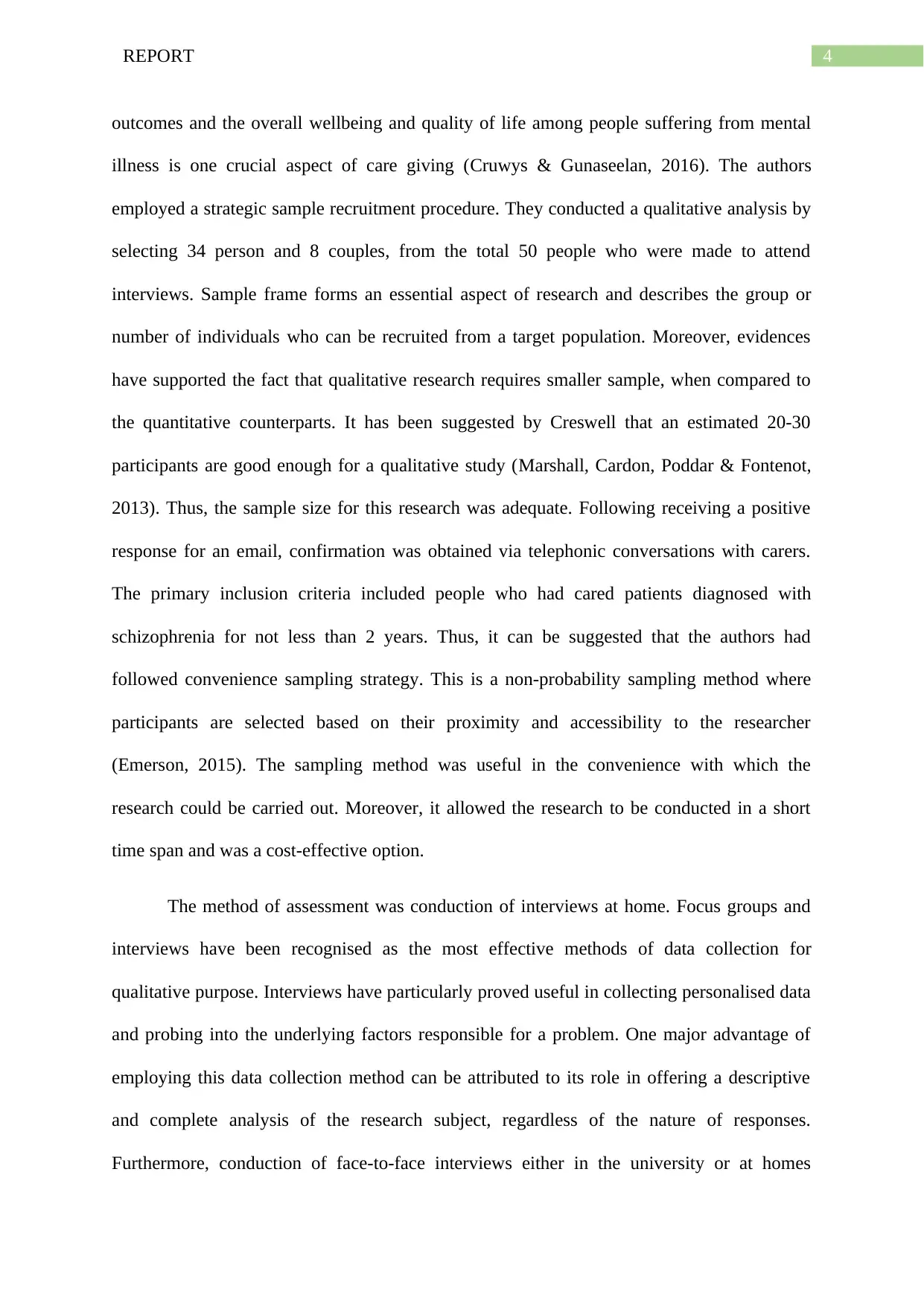
4REPORT
outcomes and the overall wellbeing and quality of life among people suffering from mental
illness is one crucial aspect of care giving (Cruwys & Gunaseelan, 2016). The authors
employed a strategic sample recruitment procedure. They conducted a qualitative analysis by
selecting 34 person and 8 couples, from the total 50 people who were made to attend
interviews. Sample frame forms an essential aspect of research and describes the group or
number of individuals who can be recruited from a target population. Moreover, evidences
have supported the fact that qualitative research requires smaller sample, when compared to
the quantitative counterparts. It has been suggested by Creswell that an estimated 20-30
participants are good enough for a qualitative study (Marshall, Cardon, Poddar & Fontenot,
2013). Thus, the sample size for this research was adequate. Following receiving a positive
response for an email, confirmation was obtained via telephonic conversations with carers.
The primary inclusion criteria included people who had cared patients diagnosed with
schizophrenia for not less than 2 years. Thus, it can be suggested that the authors had
followed convenience sampling strategy. This is a non-probability sampling method where
participants are selected based on their proximity and accessibility to the researcher
(Emerson, 2015). The sampling method was useful in the convenience with which the
research could be carried out. Moreover, it allowed the research to be conducted in a short
time span and was a cost-effective option.
The method of assessment was conduction of interviews at home. Focus groups and
interviews have been recognised as the most effective methods of data collection for
qualitative purpose. Interviews have particularly proved useful in collecting personalised data
and probing into the underlying factors responsible for a problem. One major advantage of
employing this data collection method can be attributed to its role in offering a descriptive
and complete analysis of the research subject, regardless of the nature of responses.
Furthermore, conduction of face-to-face interviews either in the university or at homes
outcomes and the overall wellbeing and quality of life among people suffering from mental
illness is one crucial aspect of care giving (Cruwys & Gunaseelan, 2016). The authors
employed a strategic sample recruitment procedure. They conducted a qualitative analysis by
selecting 34 person and 8 couples, from the total 50 people who were made to attend
interviews. Sample frame forms an essential aspect of research and describes the group or
number of individuals who can be recruited from a target population. Moreover, evidences
have supported the fact that qualitative research requires smaller sample, when compared to
the quantitative counterparts. It has been suggested by Creswell that an estimated 20-30
participants are good enough for a qualitative study (Marshall, Cardon, Poddar & Fontenot,
2013). Thus, the sample size for this research was adequate. Following receiving a positive
response for an email, confirmation was obtained via telephonic conversations with carers.
The primary inclusion criteria included people who had cared patients diagnosed with
schizophrenia for not less than 2 years. Thus, it can be suggested that the authors had
followed convenience sampling strategy. This is a non-probability sampling method where
participants are selected based on their proximity and accessibility to the researcher
(Emerson, 2015). The sampling method was useful in the convenience with which the
research could be carried out. Moreover, it allowed the research to be conducted in a short
time span and was a cost-effective option.
The method of assessment was conduction of interviews at home. Focus groups and
interviews have been recognised as the most effective methods of data collection for
qualitative purpose. Interviews have particularly proved useful in collecting personalised data
and probing into the underlying factors responsible for a problem. One major advantage of
employing this data collection method can be attributed to its role in offering a descriptive
and complete analysis of the research subject, regardless of the nature of responses.
Furthermore, conduction of face-to-face interviews either in the university or at homes

5REPORT
provided the key advantage of capturing essential non-verbal and verbal cues, by creating the
provision of observing the expressions and body language of the carers. However, one major
limitation was associated with gender bias among the respondents (Irvine, Drew & Sainsbury,
2013). This faulty methodology might have resulted in incorrect results. Furthermore, the
convenience sampling technique had high possibilities of sampling errors, and probability of
a bias. Bias might have occurred because some of the groups were over-represented.
Article 2
Ho, R. T. H., Chan, C. K. P., Lo, P. H. Y., Wong, P. H., Chan, C. L. W., Leung, P. P. Y., &
Chen, E. Y. H. (2016). Understandings of spirituality and its role in illness recovery in
persons with schizophrenia and mental-health professionals: a qualitative study. BMC
psychiatry, 16(1), 86. DOI 10.1186/s12888-016-0796-7
Ho et al., (2016) conducted a qualitative study for determining the roles and meanings
of spirituality from the perspective of schizophrenic individuals and other mental health
workers. The researchers were accurate in developing the foundation of their research on the
need of spiritual and psychosocial care for mental disorders. Most psychologists hold the
view that mental disorders are intricately related to spirituality and religion in the life of all
patients (Pargament & Lomax, 2013). Hence, the study addressed a well-focused issue. A
grounded theory approach was employed by the researchers in this regard. One major
advantage of this research design is the fact that it provides a detailed methodology for the
development of an understanding of the social phenomenon, without the influence of any pre-
determined paradigms or theories. However, this grounded theory fails to identify the
embeddedness of the researchers, thereby concealing their agency in data collection and
interpretation (Cho & Lee, 2014). A method of purposeful sampling was adopted for sample
recruitment. The pros of this sampling technique are its role in reaching the target sample
rapidly, and involving multiple stages in the research design. However, this sampling process
provided the key advantage of capturing essential non-verbal and verbal cues, by creating the
provision of observing the expressions and body language of the carers. However, one major
limitation was associated with gender bias among the respondents (Irvine, Drew & Sainsbury,
2013). This faulty methodology might have resulted in incorrect results. Furthermore, the
convenience sampling technique had high possibilities of sampling errors, and probability of
a bias. Bias might have occurred because some of the groups were over-represented.
Article 2
Ho, R. T. H., Chan, C. K. P., Lo, P. H. Y., Wong, P. H., Chan, C. L. W., Leung, P. P. Y., &
Chen, E. Y. H. (2016). Understandings of spirituality and its role in illness recovery in
persons with schizophrenia and mental-health professionals: a qualitative study. BMC
psychiatry, 16(1), 86. DOI 10.1186/s12888-016-0796-7
Ho et al., (2016) conducted a qualitative study for determining the roles and meanings
of spirituality from the perspective of schizophrenic individuals and other mental health
workers. The researchers were accurate in developing the foundation of their research on the
need of spiritual and psychosocial care for mental disorders. Most psychologists hold the
view that mental disorders are intricately related to spirituality and religion in the life of all
patients (Pargament & Lomax, 2013). Hence, the study addressed a well-focused issue. A
grounded theory approach was employed by the researchers in this regard. One major
advantage of this research design is the fact that it provides a detailed methodology for the
development of an understanding of the social phenomenon, without the influence of any pre-
determined paradigms or theories. However, this grounded theory fails to identify the
embeddedness of the researchers, thereby concealing their agency in data collection and
interpretation (Cho & Lee, 2014). A method of purposeful sampling was adopted for sample
recruitment. The pros of this sampling technique are its role in reaching the target sample
rapidly, and involving multiple stages in the research design. However, this sampling process
⊘ This is a preview!⊘
Do you want full access?
Subscribe today to unlock all pages.

Trusted by 1+ million students worldwide
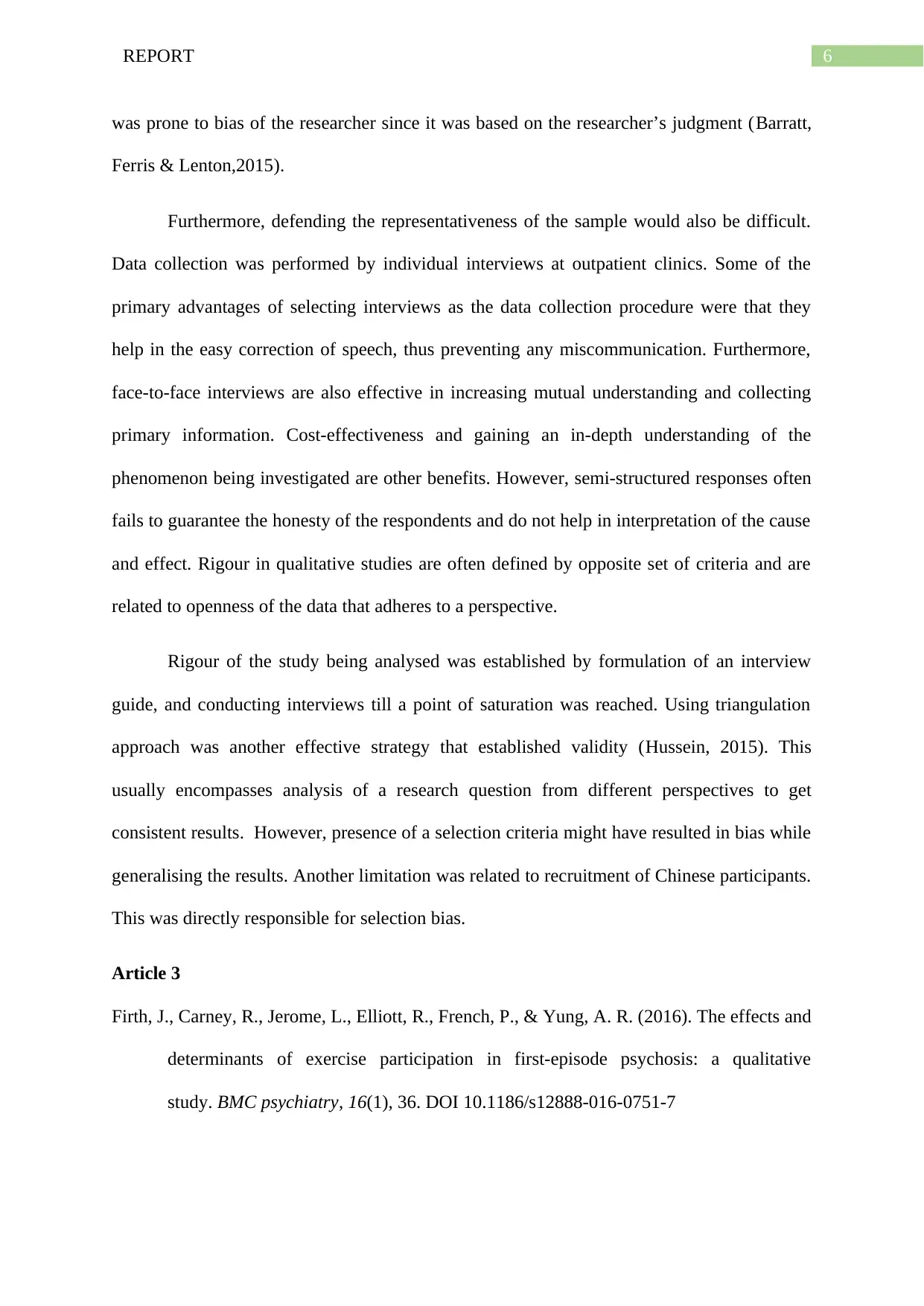
6REPORT
was prone to bias of the researcher since it was based on the researcher’s judgment (Barratt,
Ferris & Lenton,2015).
Furthermore, defending the representativeness of the sample would also be difficult.
Data collection was performed by individual interviews at outpatient clinics. Some of the
primary advantages of selecting interviews as the data collection procedure were that they
help in the easy correction of speech, thus preventing any miscommunication. Furthermore,
face-to-face interviews are also effective in increasing mutual understanding and collecting
primary information. Cost-effectiveness and gaining an in-depth understanding of the
phenomenon being investigated are other benefits. However, semi-structured responses often
fails to guarantee the honesty of the respondents and do not help in interpretation of the cause
and effect. Rigour in qualitative studies are often defined by opposite set of criteria and are
related to openness of the data that adheres to a perspective.
Rigour of the study being analysed was established by formulation of an interview
guide, and conducting interviews till a point of saturation was reached. Using triangulation
approach was another effective strategy that established validity (Hussein, 2015). This
usually encompasses analysis of a research question from different perspectives to get
consistent results. However, presence of a selection criteria might have resulted in bias while
generalising the results. Another limitation was related to recruitment of Chinese participants.
This was directly responsible for selection bias.
Article 3
Firth, J., Carney, R., Jerome, L., Elliott, R., French, P., & Yung, A. R. (2016). The effects and
determinants of exercise participation in first-episode psychosis: a qualitative
study. BMC psychiatry, 16(1), 36. DOI 10.1186/s12888-016-0751-7
was prone to bias of the researcher since it was based on the researcher’s judgment (Barratt,
Ferris & Lenton,2015).
Furthermore, defending the representativeness of the sample would also be difficult.
Data collection was performed by individual interviews at outpatient clinics. Some of the
primary advantages of selecting interviews as the data collection procedure were that they
help in the easy correction of speech, thus preventing any miscommunication. Furthermore,
face-to-face interviews are also effective in increasing mutual understanding and collecting
primary information. Cost-effectiveness and gaining an in-depth understanding of the
phenomenon being investigated are other benefits. However, semi-structured responses often
fails to guarantee the honesty of the respondents and do not help in interpretation of the cause
and effect. Rigour in qualitative studies are often defined by opposite set of criteria and are
related to openness of the data that adheres to a perspective.
Rigour of the study being analysed was established by formulation of an interview
guide, and conducting interviews till a point of saturation was reached. Using triangulation
approach was another effective strategy that established validity (Hussein, 2015). This
usually encompasses analysis of a research question from different perspectives to get
consistent results. However, presence of a selection criteria might have resulted in bias while
generalising the results. Another limitation was related to recruitment of Chinese participants.
This was directly responsible for selection bias.
Article 3
Firth, J., Carney, R., Jerome, L., Elliott, R., French, P., & Yung, A. R. (2016). The effects and
determinants of exercise participation in first-episode psychosis: a qualitative
study. BMC psychiatry, 16(1), 36. DOI 10.1186/s12888-016-0751-7
Paraphrase This Document
Need a fresh take? Get an instant paraphrase of this document with our AI Paraphraser
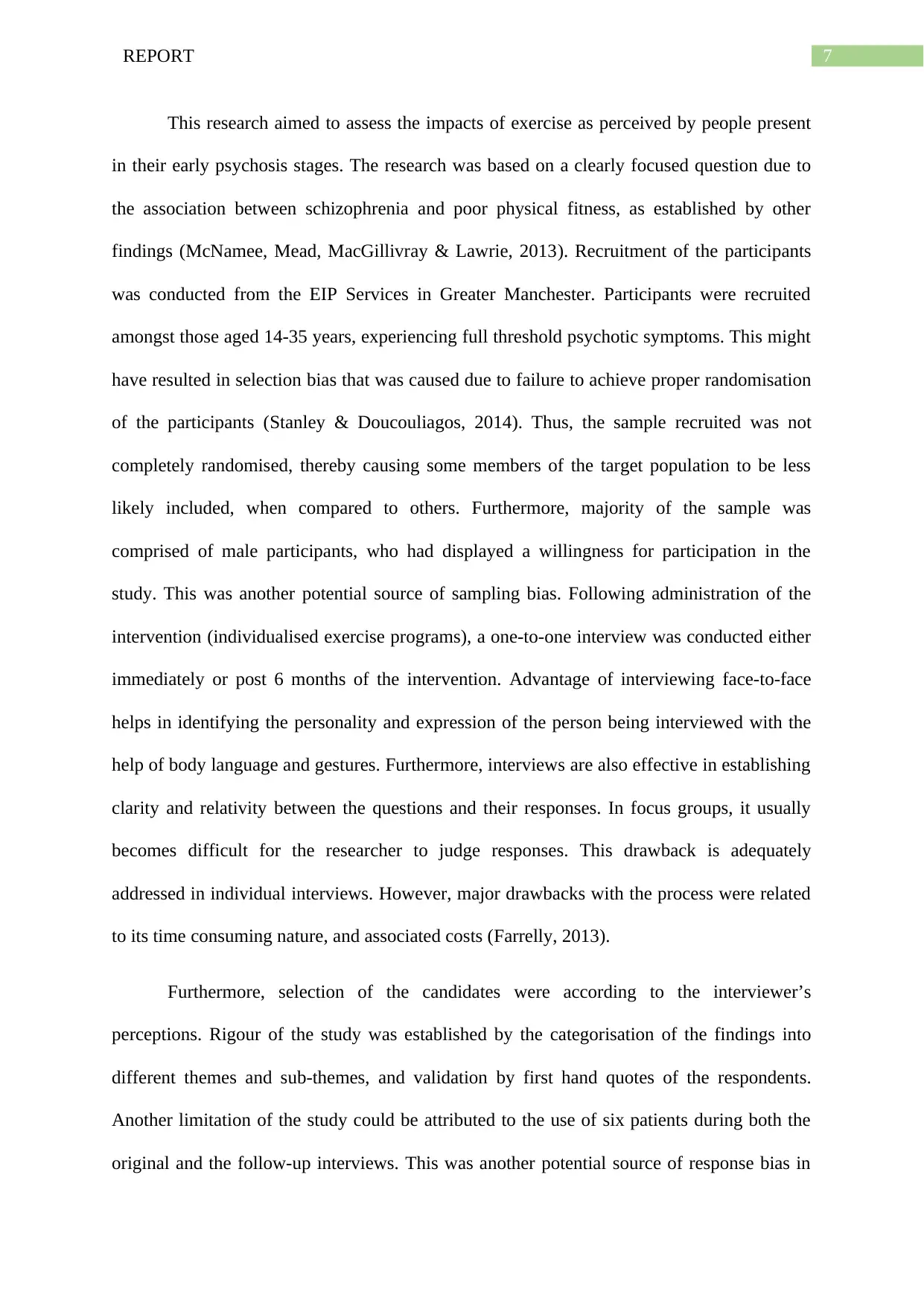
7REPORT
This research aimed to assess the impacts of exercise as perceived by people present
in their early psychosis stages. The research was based on a clearly focused question due to
the association between schizophrenia and poor physical fitness, as established by other
findings (McNamee, Mead, MacGillivray & Lawrie, 2013). Recruitment of the participants
was conducted from the EIP Services in Greater Manchester. Participants were recruited
amongst those aged 14-35 years, experiencing full threshold psychotic symptoms. This might
have resulted in selection bias that was caused due to failure to achieve proper randomisation
of the participants (Stanley & Doucouliagos, 2014). Thus, the sample recruited was not
completely randomised, thereby causing some members of the target population to be less
likely included, when compared to others. Furthermore, majority of the sample was
comprised of male participants, who had displayed a willingness for participation in the
study. This was another potential source of sampling bias. Following administration of the
intervention (individualised exercise programs), a one-to-one interview was conducted either
immediately or post 6 months of the intervention. Advantage of interviewing face-to-face
helps in identifying the personality and expression of the person being interviewed with the
help of body language and gestures. Furthermore, interviews are also effective in establishing
clarity and relativity between the questions and their responses. In focus groups, it usually
becomes difficult for the researcher to judge responses. This drawback is adequately
addressed in individual interviews. However, major drawbacks with the process were related
to its time consuming nature, and associated costs (Farrelly, 2013).
Furthermore, selection of the candidates were according to the interviewer’s
perceptions. Rigour of the study was established by the categorisation of the findings into
different themes and sub-themes, and validation by first hand quotes of the respondents.
Another limitation of the study could be attributed to the use of six patients during both the
original and the follow-up interviews. This was another potential source of response bias in
This research aimed to assess the impacts of exercise as perceived by people present
in their early psychosis stages. The research was based on a clearly focused question due to
the association between schizophrenia and poor physical fitness, as established by other
findings (McNamee, Mead, MacGillivray & Lawrie, 2013). Recruitment of the participants
was conducted from the EIP Services in Greater Manchester. Participants were recruited
amongst those aged 14-35 years, experiencing full threshold psychotic symptoms. This might
have resulted in selection bias that was caused due to failure to achieve proper randomisation
of the participants (Stanley & Doucouliagos, 2014). Thus, the sample recruited was not
completely randomised, thereby causing some members of the target population to be less
likely included, when compared to others. Furthermore, majority of the sample was
comprised of male participants, who had displayed a willingness for participation in the
study. This was another potential source of sampling bias. Following administration of the
intervention (individualised exercise programs), a one-to-one interview was conducted either
immediately or post 6 months of the intervention. Advantage of interviewing face-to-face
helps in identifying the personality and expression of the person being interviewed with the
help of body language and gestures. Furthermore, interviews are also effective in establishing
clarity and relativity between the questions and their responses. In focus groups, it usually
becomes difficult for the researcher to judge responses. This drawback is adequately
addressed in individual interviews. However, major drawbacks with the process were related
to its time consuming nature, and associated costs (Farrelly, 2013).
Furthermore, selection of the candidates were according to the interviewer’s
perceptions. Rigour of the study was established by the categorisation of the findings into
different themes and sub-themes, and validation by first hand quotes of the respondents.
Another limitation of the study could be attributed to the use of six patients during both the
original and the follow-up interviews. This was another potential source of response bias in
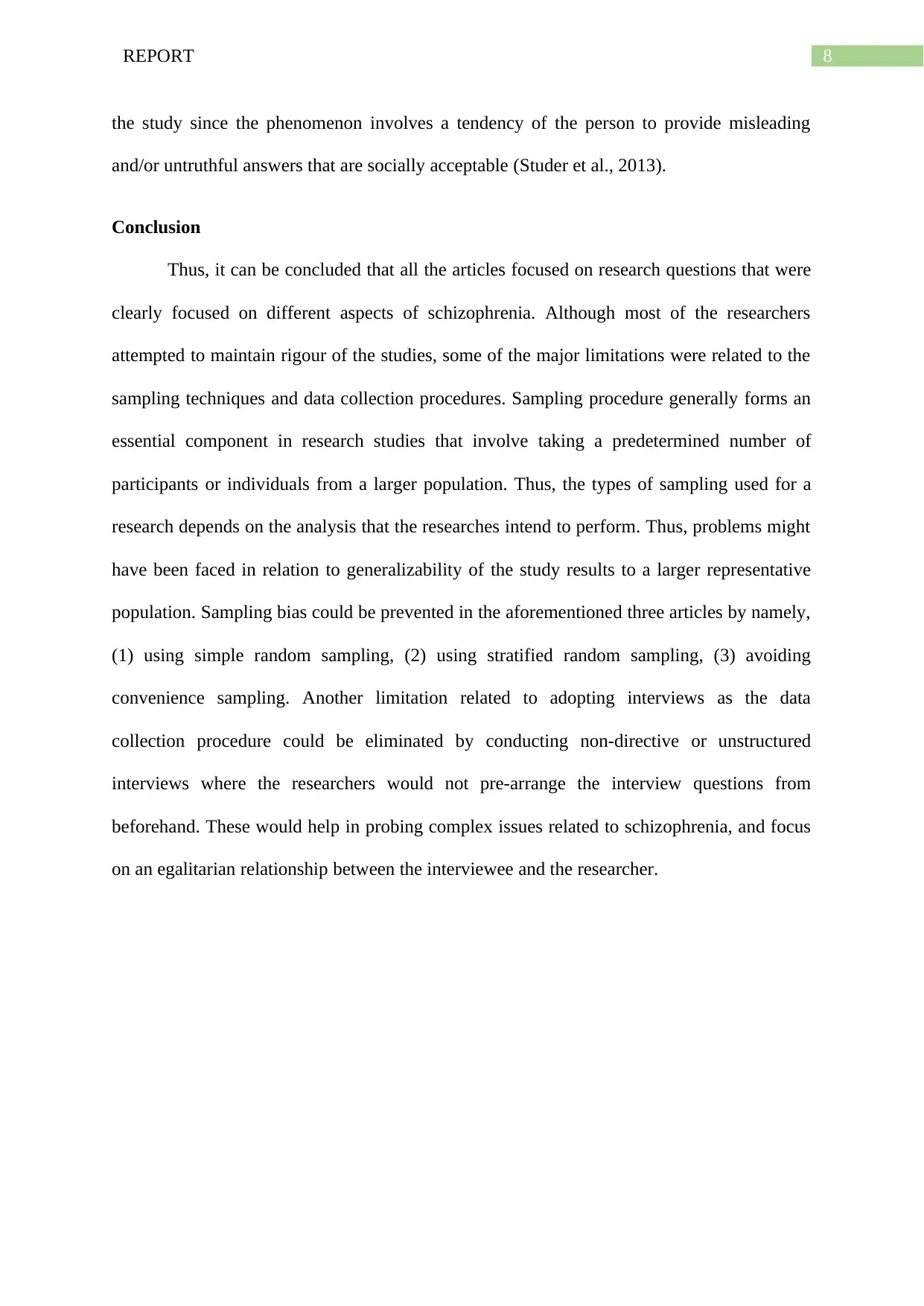
8REPORT
the study since the phenomenon involves a tendency of the person to provide misleading
and/or untruthful answers that are socially acceptable (Studer et al., 2013).
Conclusion
Thus, it can be concluded that all the articles focused on research questions that were
clearly focused on different aspects of schizophrenia. Although most of the researchers
attempted to maintain rigour of the studies, some of the major limitations were related to the
sampling techniques and data collection procedures. Sampling procedure generally forms an
essential component in research studies that involve taking a predetermined number of
participants or individuals from a larger population. Thus, the types of sampling used for a
research depends on the analysis that the researches intend to perform. Thus, problems might
have been faced in relation to generalizability of the study results to a larger representative
population. Sampling bias could be prevented in the aforementioned three articles by namely,
(1) using simple random sampling, (2) using stratified random sampling, (3) avoiding
convenience sampling. Another limitation related to adopting interviews as the data
collection procedure could be eliminated by conducting non-directive or unstructured
interviews where the researchers would not pre-arrange the interview questions from
beforehand. These would help in probing complex issues related to schizophrenia, and focus
on an egalitarian relationship between the interviewee and the researcher.
the study since the phenomenon involves a tendency of the person to provide misleading
and/or untruthful answers that are socially acceptable (Studer et al., 2013).
Conclusion
Thus, it can be concluded that all the articles focused on research questions that were
clearly focused on different aspects of schizophrenia. Although most of the researchers
attempted to maintain rigour of the studies, some of the major limitations were related to the
sampling techniques and data collection procedures. Sampling procedure generally forms an
essential component in research studies that involve taking a predetermined number of
participants or individuals from a larger population. Thus, the types of sampling used for a
research depends on the analysis that the researches intend to perform. Thus, problems might
have been faced in relation to generalizability of the study results to a larger representative
population. Sampling bias could be prevented in the aforementioned three articles by namely,
(1) using simple random sampling, (2) using stratified random sampling, (3) avoiding
convenience sampling. Another limitation related to adopting interviews as the data
collection procedure could be eliminated by conducting non-directive or unstructured
interviews where the researchers would not pre-arrange the interview questions from
beforehand. These would help in probing complex issues related to schizophrenia, and focus
on an egalitarian relationship between the interviewee and the researcher.
⊘ This is a preview!⊘
Do you want full access?
Subscribe today to unlock all pages.

Trusted by 1+ million students worldwide
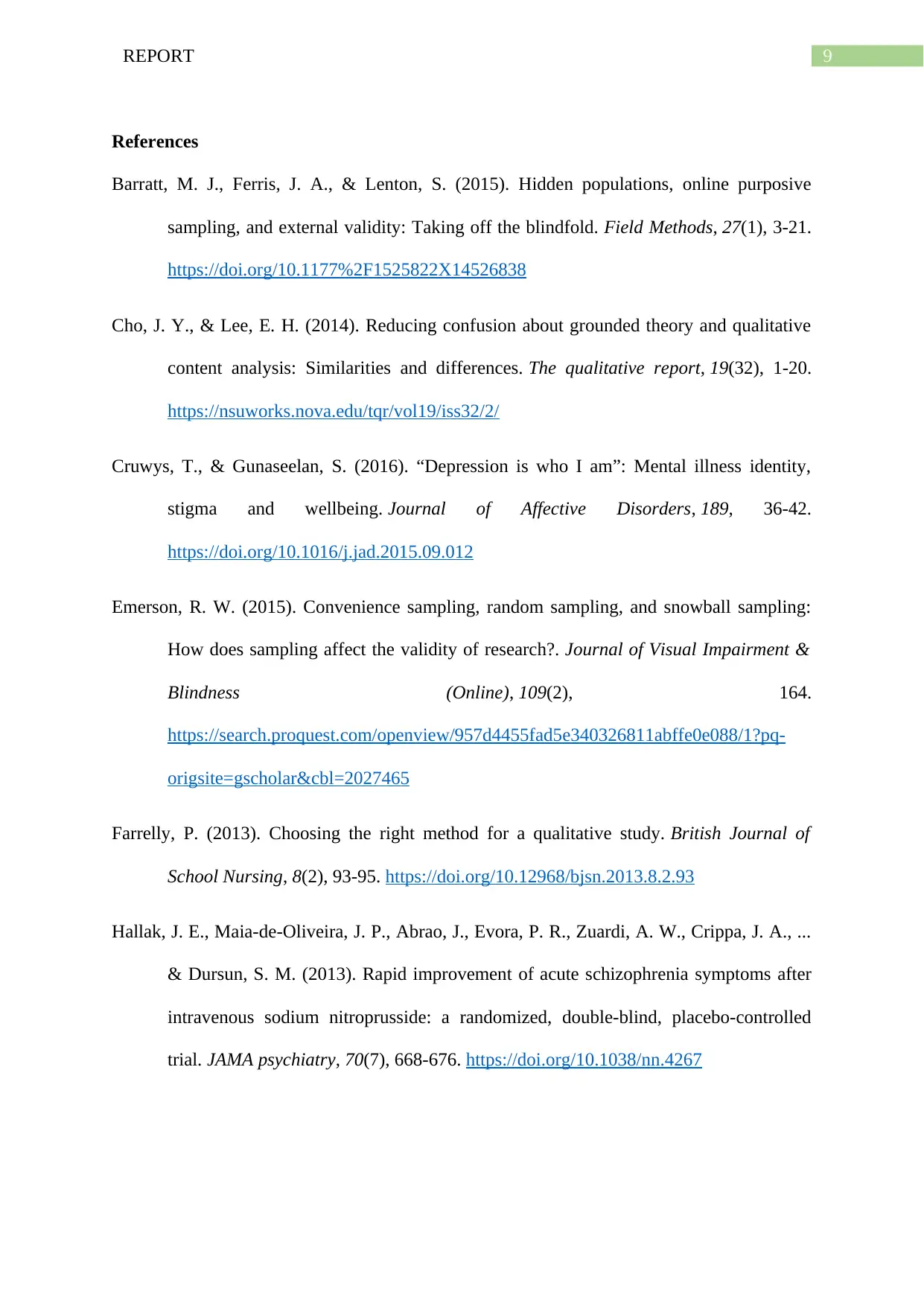
9REPORT
References
Barratt, M. J., Ferris, J. A., & Lenton, S. (2015). Hidden populations, online purposive
sampling, and external validity: Taking off the blindfold. Field Methods, 27(1), 3-21.
https://doi.org/10.1177%2F1525822X14526838
Cho, J. Y., & Lee, E. H. (2014). Reducing confusion about grounded theory and qualitative
content analysis: Similarities and differences. The qualitative report, 19(32), 1-20.
https://nsuworks.nova.edu/tqr/vol19/iss32/2/
Cruwys, T., & Gunaseelan, S. (2016). “Depression is who I am”: Mental illness identity,
stigma and wellbeing. Journal of Affective Disorders, 189, 36-42.
https://doi.org/10.1016/j.jad.2015.09.012
Emerson, R. W. (2015). Convenience sampling, random sampling, and snowball sampling:
How does sampling affect the validity of research?. Journal of Visual Impairment &
Blindness (Online), 109(2), 164.
https://search.proquest.com/openview/957d4455fad5e340326811abffe0e088/1?pq-
origsite=gscholar&cbl=2027465
Farrelly, P. (2013). Choosing the right method for a qualitative study. British Journal of
School Nursing, 8(2), 93-95. https://doi.org/10.12968/bjsn.2013.8.2.93
Hallak, J. E., Maia-de-Oliveira, J. P., Abrao, J., Evora, P. R., Zuardi, A. W., Crippa, J. A., ...
& Dursun, S. M. (2013). Rapid improvement of acute schizophrenia symptoms after
intravenous sodium nitroprusside: a randomized, double-blind, placebo-controlled
trial. JAMA psychiatry, 70(7), 668-676. https://doi.org/10.1038/nn.4267
References
Barratt, M. J., Ferris, J. A., & Lenton, S. (2015). Hidden populations, online purposive
sampling, and external validity: Taking off the blindfold. Field Methods, 27(1), 3-21.
https://doi.org/10.1177%2F1525822X14526838
Cho, J. Y., & Lee, E. H. (2014). Reducing confusion about grounded theory and qualitative
content analysis: Similarities and differences. The qualitative report, 19(32), 1-20.
https://nsuworks.nova.edu/tqr/vol19/iss32/2/
Cruwys, T., & Gunaseelan, S. (2016). “Depression is who I am”: Mental illness identity,
stigma and wellbeing. Journal of Affective Disorders, 189, 36-42.
https://doi.org/10.1016/j.jad.2015.09.012
Emerson, R. W. (2015). Convenience sampling, random sampling, and snowball sampling:
How does sampling affect the validity of research?. Journal of Visual Impairment &
Blindness (Online), 109(2), 164.
https://search.proquest.com/openview/957d4455fad5e340326811abffe0e088/1?pq-
origsite=gscholar&cbl=2027465
Farrelly, P. (2013). Choosing the right method for a qualitative study. British Journal of
School Nursing, 8(2), 93-95. https://doi.org/10.12968/bjsn.2013.8.2.93
Hallak, J. E., Maia-de-Oliveira, J. P., Abrao, J., Evora, P. R., Zuardi, A. W., Crippa, J. A., ...
& Dursun, S. M. (2013). Rapid improvement of acute schizophrenia symptoms after
intravenous sodium nitroprusside: a randomized, double-blind, placebo-controlled
trial. JAMA psychiatry, 70(7), 668-676. https://doi.org/10.1038/nn.4267
Paraphrase This Document
Need a fresh take? Get an instant paraphrase of this document with our AI Paraphraser

10REPORT
Hussein, A. (2015). The use of triangulation in social sciences research: Can qualitative and
quantitative methods be combined?. Journal of comparative social work, 4(1).
http://journal.uia.no/index.php/JCSW/article/viewFile/212/147
Irvine, A., Drew, P., & Sainsbury, R. (2013). ‘Am I not answering your questions
properly?’Clarification, adequacy and responsiveness in semi-structured telephone
and face-to-face interviews. Qualitative Research, 13(1), 87-106.
https://doi.org/10.1177%2F1468794112439086
Marshall, B., Cardon, P., Poddar, A., & Fontenot, R. (2013). Does sample size matter in
qualitative research?: A review of qualitative interviews in IS research. Journal of
Computer Information Systems, 54(1), 11-22.
https://doi.org/10.1080/08874417.2013.11645667
McNamee, L., Mead, G., MacGillivray, S., & Lawrie, S. M. (2013). Schizophrenia, poor
physical health and physical activity: evidence-based interventions are required to
reduce major health inequalities. The British Journal of Psychiatry, 203(4), 239-241.
https://doi.org/10.1192/bjp.bp.112.125070
Meehl, P. E. (2017). Schizotaxia, schizotypy, schizophrenia. In Schizophrenia (pp. 21-46).
Routledge. http://www.subjectpool.com/ed_teach/y4general_paper/meehl1962.pdf
Modinos, G., Costafreda, S. G., van Tol, M. J., McGuire, P. K., Aleman, A., & Allen, P.
(2013). Neuroanatomy of auditory verbal hallucinations in schizophrenia: a
quantitative meta-analysis of voxel-based morphometry studies. cortex, 49(4), 1046-
1055. https://doi.org/10.1016/j.cortex.2012.01.009
Pargament, K. I., & Lomax, J. W. (2013). Understanding and addressing religion among
people with mental illness. World Psychiatry, 12(1), 26-32.
https://doi.org/10.1002/wps.20005
Hussein, A. (2015). The use of triangulation in social sciences research: Can qualitative and
quantitative methods be combined?. Journal of comparative social work, 4(1).
http://journal.uia.no/index.php/JCSW/article/viewFile/212/147
Irvine, A., Drew, P., & Sainsbury, R. (2013). ‘Am I not answering your questions
properly?’Clarification, adequacy and responsiveness in semi-structured telephone
and face-to-face interviews. Qualitative Research, 13(1), 87-106.
https://doi.org/10.1177%2F1468794112439086
Marshall, B., Cardon, P., Poddar, A., & Fontenot, R. (2013). Does sample size matter in
qualitative research?: A review of qualitative interviews in IS research. Journal of
Computer Information Systems, 54(1), 11-22.
https://doi.org/10.1080/08874417.2013.11645667
McNamee, L., Mead, G., MacGillivray, S., & Lawrie, S. M. (2013). Schizophrenia, poor
physical health and physical activity: evidence-based interventions are required to
reduce major health inequalities. The British Journal of Psychiatry, 203(4), 239-241.
https://doi.org/10.1192/bjp.bp.112.125070
Meehl, P. E. (2017). Schizotaxia, schizotypy, schizophrenia. In Schizophrenia (pp. 21-46).
Routledge. http://www.subjectpool.com/ed_teach/y4general_paper/meehl1962.pdf
Modinos, G., Costafreda, S. G., van Tol, M. J., McGuire, P. K., Aleman, A., & Allen, P.
(2013). Neuroanatomy of auditory verbal hallucinations in schizophrenia: a
quantitative meta-analysis of voxel-based morphometry studies. cortex, 49(4), 1046-
1055. https://doi.org/10.1016/j.cortex.2012.01.009
Pargament, K. I., & Lomax, J. W. (2013). Understanding and addressing religion among
people with mental illness. World Psychiatry, 12(1), 26-32.
https://doi.org/10.1002/wps.20005

11REPORT
Stanley, T. D., & Doucouliagos, H. (2014). Meta‐regression approximations to reduce
publication selection bias. Research Synthesis Methods, 5(1), 60-78.
https://doi.org/10.1002/jrsm.1095
Studer, J., Baggio, S., Mohler-Kuo, M., Dermota, P., Gaume, J., Bertholet, N., ... & Gmel, G.
(2013). Examining non-response bias in substance use research—Are late respondents
proxies for non-respondents?. Drug and Alcohol Dependence, 132(1-2), 316-323.
https://doi.org/10.1016/j.drugalcdep.2013.02.029
Stanley, T. D., & Doucouliagos, H. (2014). Meta‐regression approximations to reduce
publication selection bias. Research Synthesis Methods, 5(1), 60-78.
https://doi.org/10.1002/jrsm.1095
Studer, J., Baggio, S., Mohler-Kuo, M., Dermota, P., Gaume, J., Bertholet, N., ... & Gmel, G.
(2013). Examining non-response bias in substance use research—Are late respondents
proxies for non-respondents?. Drug and Alcohol Dependence, 132(1-2), 316-323.
https://doi.org/10.1016/j.drugalcdep.2013.02.029
⊘ This is a preview!⊘
Do you want full access?
Subscribe today to unlock all pages.

Trusted by 1+ million students worldwide
1 out of 12
Related Documents
Your All-in-One AI-Powered Toolkit for Academic Success.
+13062052269
info@desklib.com
Available 24*7 on WhatsApp / Email
![[object Object]](/_next/static/media/star-bottom.7253800d.svg)
Unlock your academic potential
Copyright © 2020–2025 A2Z Services. All Rights Reserved. Developed and managed by ZUCOL.





